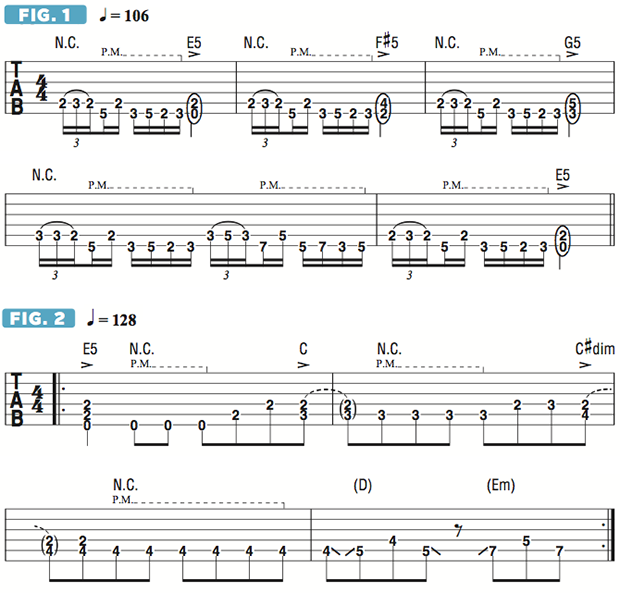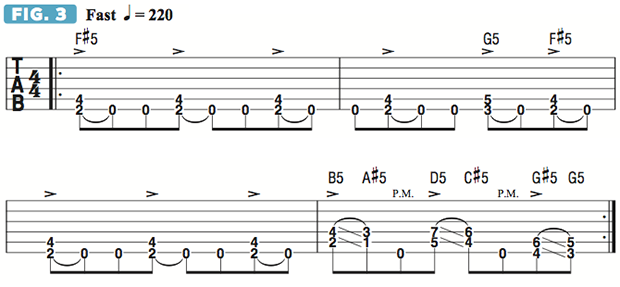How to Create Crushing Thrash Metal Rhythm Guitar Parts — Video
One of my favorite things about heavy metal music is the brutal rhythm guitar parts that have been devised by the genre's greatest bands, such as Megadeth, Metallica, Slayer and others.
In this column, I'd like to show you some of the effective techniques for developing cool-sounding and very metal rhythm guitar parts.
Crafted in the style of Megadeth's Dave Mustaine, FIGURE 1 is played in the key of E minor and is built from a combination of single notes and two-note power chords. The single-note elements of the lick are based on the E Aeolian mode (E F# G A B C D), and I begin each bar of the five-bar phrase with a 16th-note-triplet hammer-on/pull-off lick, moving between my fret-hand index and middle fingers.
The notes of this 16th-note triplet are allowed to ring out, but afterward I immediately employ palm muting (P.M.) for the remainder of the single notes played in the riff. Notice that the same figure is played across beats one and two in each bar but followed by different power chords. In bar 4, I move the hammer-on/pull-off motif one note higher within the scale, utilizing a hammer/pull between the A string’s third and fifth frets, again performed with the index and middle fingers.
FIGURE 2 is played in a classic mid-Nineties Megadeth style, and instead of playing straightforward root-fifth power chords, I play pairs of notes that function both as chords and melody simultaneously. I begin with a standard E5 powerchord, followed by an arpeggiation of the chord—each note of the chord is picked individually and in sequence. At the end of bar1, I raise the note on the A string one fret, from B to C, resulting in a C-E double-stop that creates the sound of a C chord played over an E root note.
At the end of bar 2, I raise the note on the A another half step, to C#, which creates an A/C#-over-E sound, after which I wrap things up with sliding single notes that outline D major, followed by E minor. When examining this part overall, you’ll see that I’ve combined a chunky eighth-note-driven rhythm figure with a single-note melody in a powerful way.
The last example, FIGURE 3, is played in more of a speed metal style, along the lines of what you will find in the music of bands such as Exodus and Forbidden, as well as early Metallica. It’s played at a very fast tempo—220 beats per minute!—with a “threes on fours” rhythmic feel, as the phrasing of the riff, played in steady eighth notes, is based on three-note groups.
Get The Pick Newsletter
All the latest guitar news, interviews, lessons, reviews, deals and more, direct to your inbox!


"Upgrading from your entry-level acoustic opens the door to an entirely new world of tonewoods, body shapes, and brands": 6 signs it's time to upgrade from your first acoustic guitar
"I'm past my prime": 5 common excuses for not learning the guitar – and 5 body and mind-boosting reasons you should









